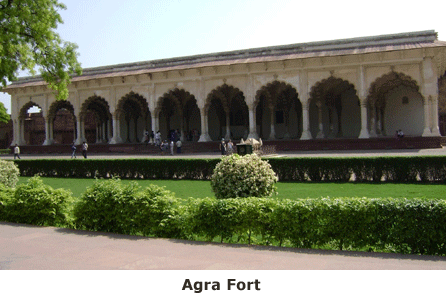AGRA FORTEmperor Akbar the Great commissioned the Agra Fort that is also sometimes called Red Fort of Agra. During the reign of emperor Jahangir, the capital was briefly shifted to Lahore but Agra became the seat of Mughal capital one again in the reign of Akbar. Akbar became emperor in 1556 and when he consolidated himself sufficiently, he started the construction of Agra Fort in the year 1665. The fort was completed in the year 1671 but minor constructions and additions kept on happening till the reign of Shah Jahan, his grandson. It is interesting to note that during the reign of Akbar, the fort mainly served as a military garrison but by the time of Shah Jahan it also started serving as a palace and court. The fort's colossal double walls rise 20 meters in height and measure 2.5 kilometers in circumference. Typical of forts of Mogul era, Agra Fort is surrounded by a moat. The fort looks intimidating because of its lofty battlements that overlook the far stretching mansions of nobles and princes built along the riverfront. Another important and very significant structure is the dominating gateway that is surrounded by the magnificent towers, bastions and ramparts. The fort contains some of the most magnificent and subtle palaces both in red sandstone and white marble that has been built by two generations of prolific builders; Akbar and later on by Jahangir and Shah Jahan. Agra Fort is among the finest examples of the fusion architecture that has dominated the Mogul period. The assimilation of these different styles has given the buildings within the fort a distinctive look. To name a few, for example, the Jahangir Palace built by Akbar is the most magnificent blend of Persian and local style where as Divan-e-Aam mixes subtleness of Turkish exteriors with the complex pattern of Persian architecture.
|
||||||||||
|
|
||||||||||




